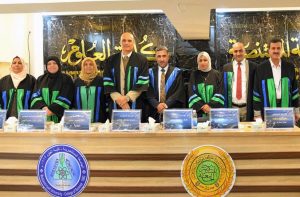College of Education for Pure Sciences, Kirkuk University discussed a master dissertation on a computational study of the spectral and thermal properties of the organic semiconductor molecule perylene and one of its derivatives using functional density theory by the postgraduate student, Ms. Maryam Qasim Ali.
The dissertation dealt with the study of two organic semiconductor molecules, which are perylene and PTCDA, using the program (Dmol3), which is one of the programs (Materials Studio), through the principles of first calculations (First – principles calculation) based on the functional density theory (DFT), and the properties were studied, as well as the spectrogram, which includes the length of bonds, the angle between atoms, the total energy and the energy levels for each molecule, which includes the energy of the highest molecular orbital occupied by electrons (HOMO) and the lowest molecular orbital unoccupied by electrons (LUMO) and calculating the energy gap between the two orbitals.
The dissertation concluded that the PTCDA molecule is more stable than the perylene molecule (because it has the lowest total energy), as well as the vibrational patterns of the perylene molecule were (90) vibrational patterns, and the PTCDA molecule had (80) patterns in the infrared region, it was concluded that the energy gap of the perylene molecule was greater than the energy gap for the PTCDA molecule because the perylene molecule works in the visible range and the PTCDA molecule works in the infrared (IR) range.
































































